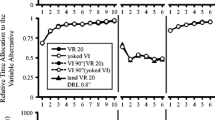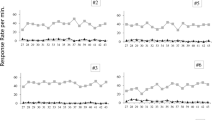Abstract
Rats received discrimination training where light-on was the S+ condition and light-off the S- condition. 2 Ss were trained with a fixed interval (FI) 30-sec. schedule with a limited hold of 5 sec. during S+, while 3 Ss were trained with a variable interval (VI) 30-sec. schedule during S+. Probe testing produced steeper generalization gradients for the FI trained Ss than for the VI trained Ss. Exp. 2 was conducted with 2 more VI Ss trained and tested in an identical manner to the FI Ss of Exp. 1. Gradients for the FI Ss of Exp. 1 were steeper than for those of the VI Ss of Exp. 2. Thus less stimulus control was exerted after training with VI than with FI schedules. The discriminative properties of reinforcement during the VI schedule competed with and thereby weakened S+ stimulus control. An alternate explanation in terms of changes in response patterns was discussed.
Similar content being viewed by others
References
BRETHOWER, D. M., & REYNOLDS, G. S. 1962. A facilitative effect of punishment on unpunished behavior. Journal of the Experimental Analysis of Behavior. 5, 191–192.
CATANIA, C. A., & REYNOLDS, G. S. 1968. A quantitative analysis of responding maintained by interval schedules of reinforcement. Journal of the Experimental Analysis of Behavior, 11, 327–383.
CRUSE, D. B., VITULLI, W., & DERTKE, M. 1966. Discriminative and reinforcing properties of two types of food pellets. Journal of the Experimental Analysis of Behavior, 9, 293–303.
HEARST, E., KORESKO, M. B., & POPPEN, R. 1964. Stimulus generalization and the response-reinforcement contingency. Journal of the Experimental Analysis of Behavior, 7, 369–380.
NEVIN, J. A., & SHETTLESWORTH, S. J. 1966. An analysis of contrast effects in multiple schedules. Journal of the Experimental Analysis of Behavior, 9, 305–315.
SEWELL, W. R., & KENDALL, S. B. 1965. A note on interresponse time distributions during generalization testing. Psychonomic Science, 3, 95–96.
SEWELL, W. R., NEWSOM, T. J. MCCOY, J. F., ATFIELD, T. STANTON, J. P., & GARNER, B. 1971. Steady state generalization following testing with different inter-probe test intervals. Journal of Perceptual Motor Skills, 33, 1283–1288.
THOMAS, D. R., & SWITALSKI, R. W. 1966. A comparison of stimulus generalization following variable ratio and variable interval training. Journal of Experimental Psychology, 71, 236–240.
ZEILER, M. D. 1969. Repeated measurements of reinforcement schedule effects on gradients of stimulus control. Journal of the Experimental Analysis of Behavior, 12, 451–461.
Author information
Authors and Affiliations
Rights and permissions
About this article
Cite this article
Newsom, T.J., McCoy, J.F., Garner, B.O. et al. Stimulus Control After Training with Fixed Interval and Variable Interval Schedules of Reinforcement. Psychol Rec 22, 413–421 (1972). https://doi.org/10.1007/BF03394108
Published:
Issue Date:
DOI: https://doi.org/10.1007/BF03394108




